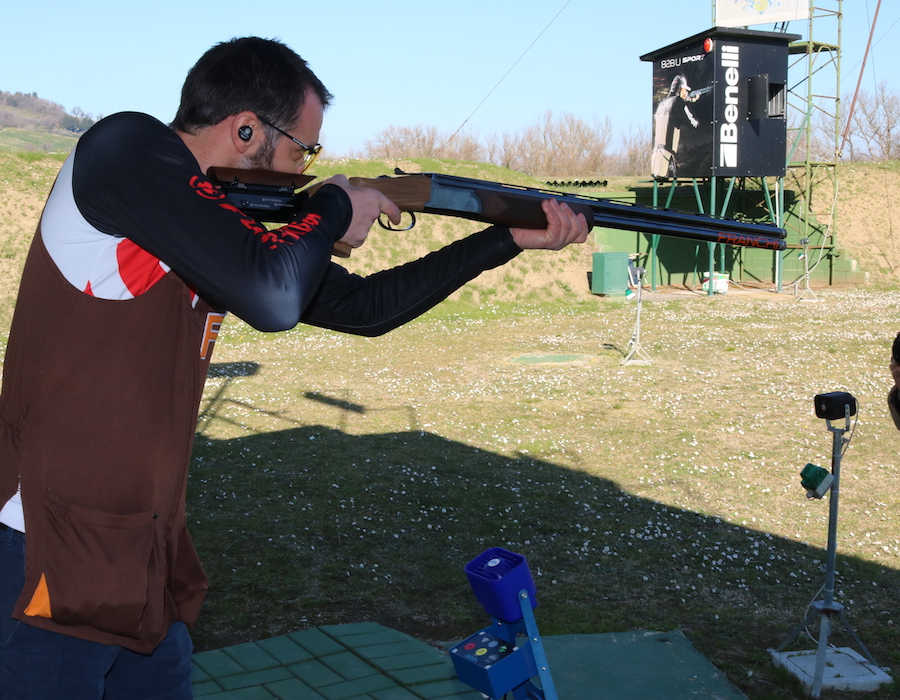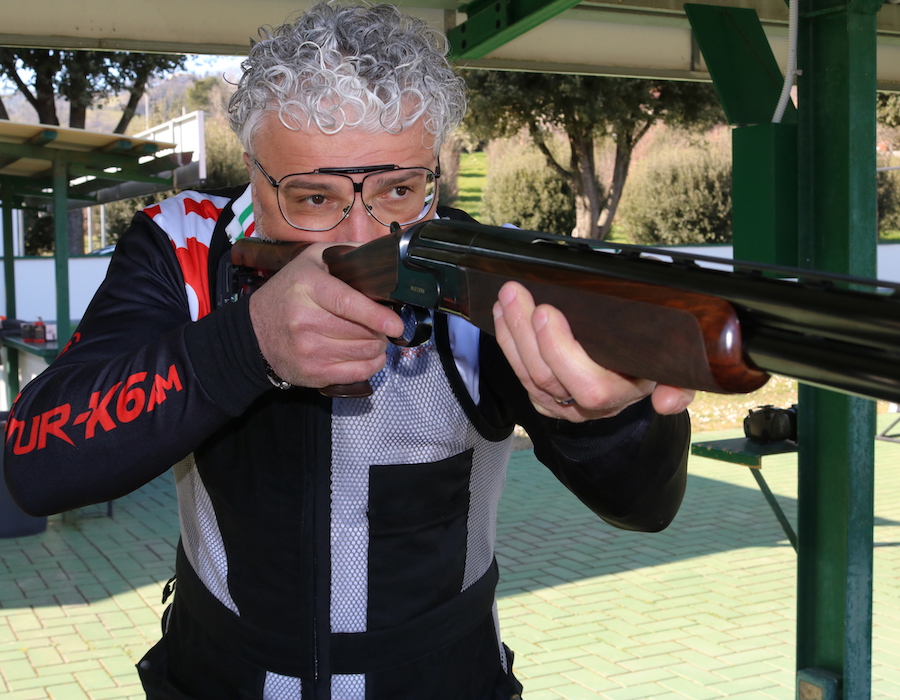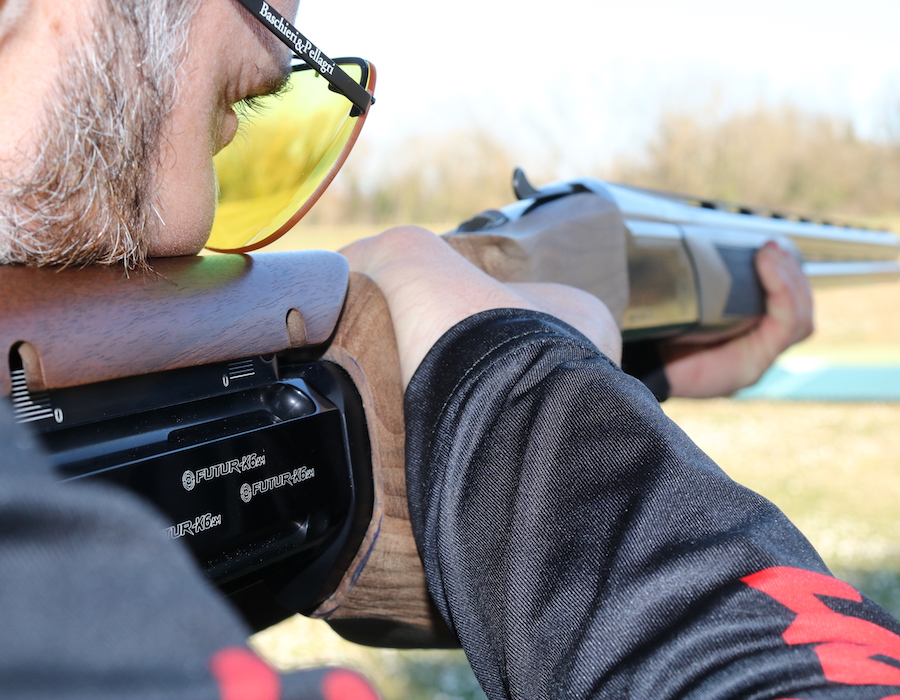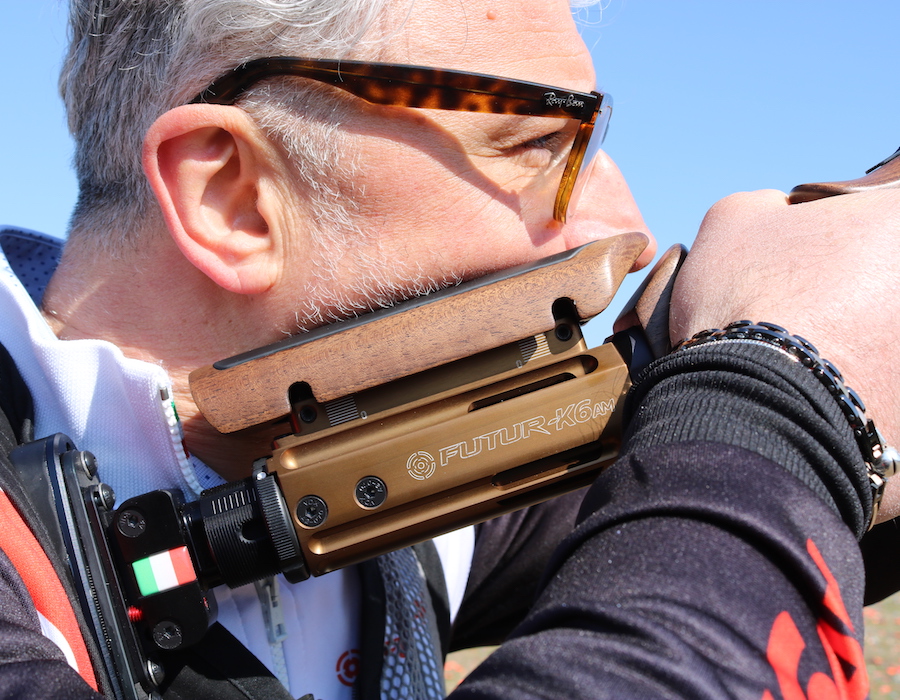Having aim means having that ability to shoulder a shotgun, aligning three crucial points: eye (or rather eyes because both must be open and focused on the gunsight), gunsight, and target, and the ability to to align and hit the latter.
However, explained in these terms, the concept of aim turns out to be too reductive.
Certainly, this term would be more understandable compared to a static shot, for example, with a rifle or a slug, but for dynamic shooting such as clay pigeon shooting, be it trap, skeet or compak, it represents only a part of the complex system that must be set in motion to succeed in hitting the target and breaking it.
Shooting on the platform seems simple. Observing the clouds that, after the shot, fill the air with color near the pit from which the targets emerge, it seems like child’s play, but only those who practice or have practiced clay pigeon shooting know how many variables come into play.
Therefore, nothing is simple or should be taken for granted. However, it is not impossible or unattainable; you just need some good advice and a good number of hours of practice.
In this article we will, in fact, talk about:

The position on the platform
Having a good stance on the platform helps a lot in clay pigeon shooting because it assists the shooter in having the best performance, transforming the human body into a real aiming system.
However, let’s go in order: it starts from the “ready position”, i.e. the starting position that is assumed when you are on the platform.
Although it commonly affects some parts of the body such as feet, hands and arms, the head can also make a concrete contribution to sight and therefore to aim, which at this stage we will understand as the ability to perceive the target as soon as it becomes apparent.
In fact, when you are in this static waiting position, it is important to keep your eyes focused on the horizon and not on the ground, a very common mistake.
In this way, the eye gets used to the wide view, light and space and is ready to shoot any object passing within the visual field. Instead, keeping your head down and getting your eyes used to looking at objects in close range and tight spaces, you lose those fractions of a second needed by the organ to get used to the different perspective and light once you look at the pit.
In fact, if you call for the target from this position, the time lost to refocus at a distance would hinder you from engaging the target in advance and hitting it.
The shooting position is different from the waiting position.
A good aim cannot disregard a correct position on the platform, which must give the body the right stability during recoil, and, at the same time, allow the right flexibility and fluidity of movements, of the torso in particular.
For this reason, many shooters tend to look for products that can mitigate the sensation of recoil, to assume increasingly natural and fluid postures, rather than rigid ones.
The use of the Futur-K6AM stock serves this purpose. Thanks to the cushioning system that reduces the recoil effect, it allows the shooter to maintain a softer, more elastic and reactive position than they otherwise would have, without running the risk of unbalancing the body by losing the line of sight and the target.
To obtain a good position, it is important to know the trajectory of the targets, which reach variable heights, from 1.5 m to 3 m, with angles from 0° to 30° both on the left and right:
- The legs must be slightly apart and the feet oriented like the position of the hands of a clock that shows 13:10
- The heels must be 25/30 cm apart
- The torso must have a 15° forward inclined position resting on the front leg
By assuming all these positions, the shooter will have the widest ability to move right, left, and upwards.
The shooter, with their eyes fixed on the pit, where the target will come out, will close the shotgun keeping one hand on the barrel cover and the kick in the armpit, then they will shoulder the shotgun and rest their cheekbone on the Montecarlo.
The neck must not be too stretched otherwise the shooter will become rigid, which will invalidate the line of sight, especially on the lateral plates. The elbows must be slightly horizontal and spread apart and the shoulders parallel to the ground.
At this point, once the shotgun has been embraced, before the target call, it is advisable to point the gunsight 10 cm below the witness on the pit. Aiming too high or too low would mean having to move your eyes first in following the moving target without being followed by the shotgun.
The eyes, rib and gunsight must be one and move in unison.

Shouldering the shotgun: grip and aim
A bad grip is the primary cause of aiming errors and missed shots.
The poor ability to shoulder the shotgun solidly, both at the height of the stock and the barrel cover, will cause poor eye, rib, sight and target alignment, also causing a movement that is not very smooth, controlled or synchronized towards the target.
In fact, hands and arms must not only support the shotgun but must stabilize it and make the shooter physically “unite” with the shotgun.
The grip points of the shotgun are important because they facilitate fluid movements and help minimize movements towards the target, that is, to make short movements, exercising greater control over the action that is taking place.
That is the reason why, especially in the most avant-garde shotgun products in the field of clay pigeon shooting, there are ergonomic handles that adapt completely to the shooter’s hand, respecting its width and length and allowing shooters to keep the shotgun firm but in a natural way, without excessively straining their muscles.
This is the case of products such as the Futur K6-AM adaptable stock created at Futurmec srl in Urbania, which, by customizing the wooden part of the handle, allows shooters to obtain a product tailored to their needs.
The flight of the clay pigeon
Once the call is made in a dry and short voice (which helps to maintain concentration), only after a few tenths of a second will the plate launched by the machine appear.
The shooter will need a tenth of a second to capture the movement of the target and two tenths to focus on it, and it is at this moment that the common mistake is made to move only the eyes by diverting them from the rib and the gunsight to follow the target, leaving the rest of the body stationary. In doing so, however, of course, the two shots available will only plough through the air.
Conversely, being able to visualize the target through the line of the barrels by moving the shotgun and body fluidly in the direction of the target will increase the chance of hitting it.
The movement of the shotgun: fluid movements and calculation in advance
The movement of the shotgun and body that follow the trajectory of the target must never be jerky or out of control.
These behaviors usually depend on the shooter’s poor concentration at the time of the call. The thinking mind does not allow the eye to see.
The shooter must therefore have the ability to create a mental void that will result in a fluid, smooth and controlled movement, aimed at centering the target and overcoming it, whatever is necessary to crush it.
Surely the speed of the shotgun must be higher than that of the target, therefore, the best condition would be to increase the aiming ability and the glance, to be able to hit the target with a short and loose movement in the first meters from its exit from the pit.
The movement of the shotgun cannot be separated from the calculation of the advance, remembering that the target leaves the pit at 120 km/h (90 in the compak specialties) and that it loses speed in contact with the air. So, the more meters it travels the slower it gets.
The same thing happens to the lead of our ammunition: you must find the limit point within which you can make the most of the shotgun’s capabilities, the maximum yield of ammunition and, why not, the qualities of the shooter.
Shooting in advance does not mean having only aim but also the right intuition, because it means shooting where the target has not yet arrived. On the other hand, shooting at the target without “playing” in advance would mean staying behind (being the object in motion) and not being able to hit the target anymore. This ability will become increasingly refined with practice, concentration and training.

Does the stock make a difference?
The answer is yes, because the stock is the element that acts as a trait d’union between shotgun and shooter, and also target. It encompasses a combination of ability and quality, without neglecting the influence on the dynamics of the aim.
In fact, a bad stock will never allow you to have a good aim, however infallible the shooter is.
But to be sure that the failure to break the targets depends on the stock, it is necessary to first carry out a series of tests, at least a dozen.
Subsequently, once the problem has been identified, the right changes can be made to the stock. However, in these cases, for those who have stocks such as the Futur K6AM, it will be easier and cheaper to find the right solution to their needs, having a product that allows you to make changes on the spot without having to resort to stock makers or gunsmiths who usually customize the wood of classic stock.
It’s one less worry for the shooter who will only have to think about aiming and the right concentration on the platform.

In conclusion
It is well understood, therefore, that when it comes to aiming in shooting, it is not only the quality in itself that the shooter must possess but the result of a series of subjective and objective factors that intertwine between them.
This result creates a unicum from which a real ability to interact between the shooter and shooting itself will be born, making sure that clay pigeon shooting becomes a fun game, a crescendo that will always put the qualities of each shooter to the test.


